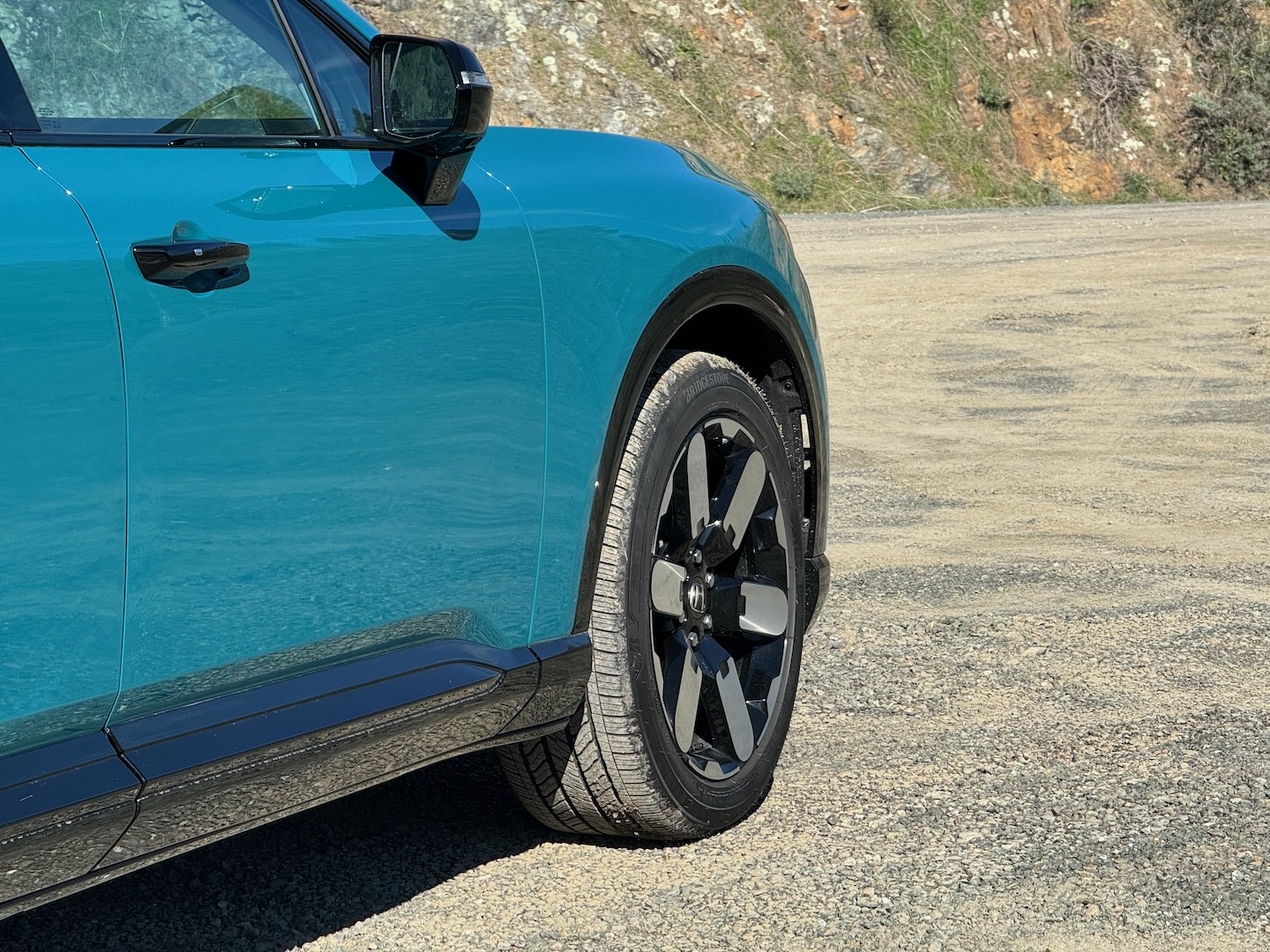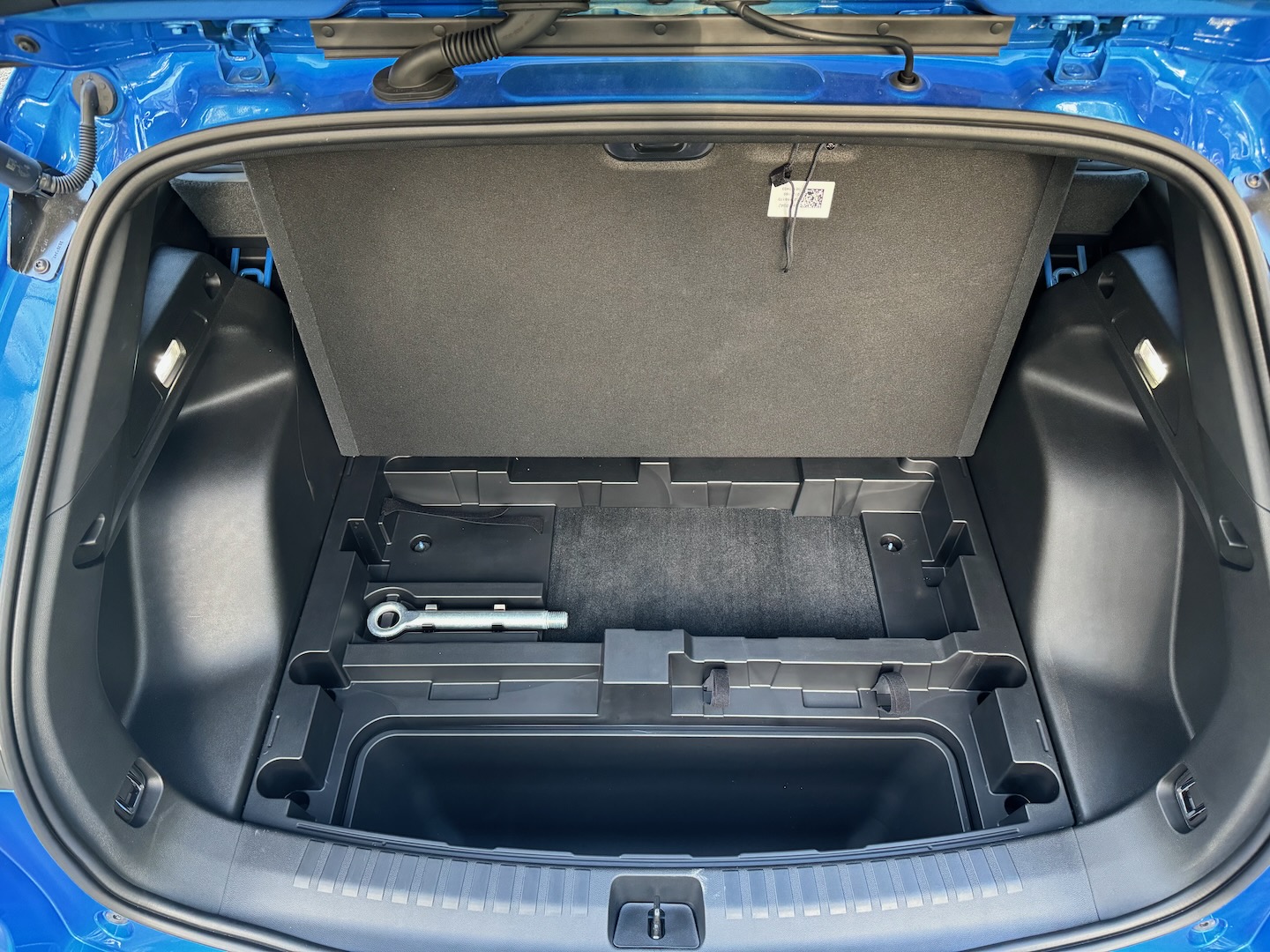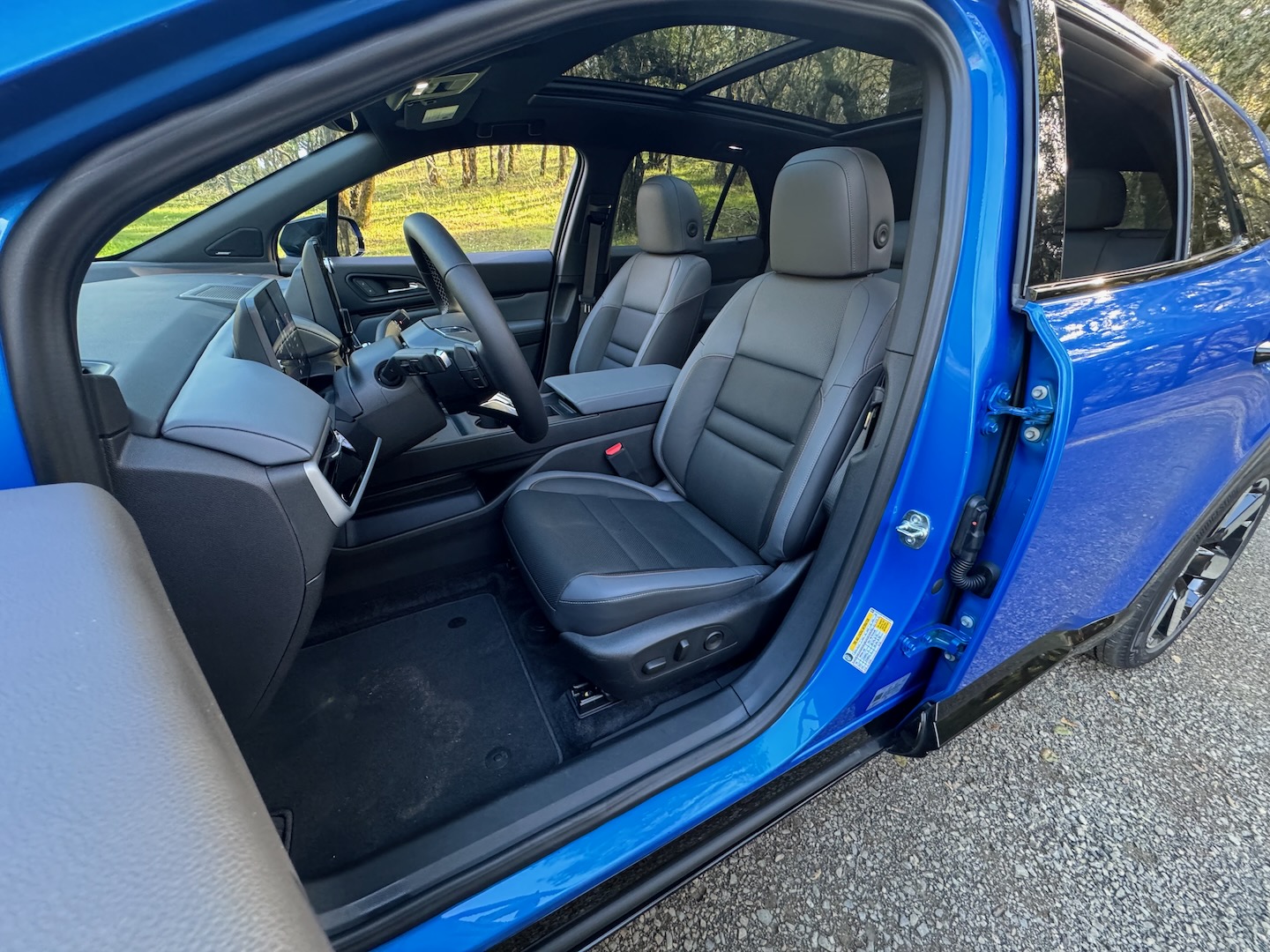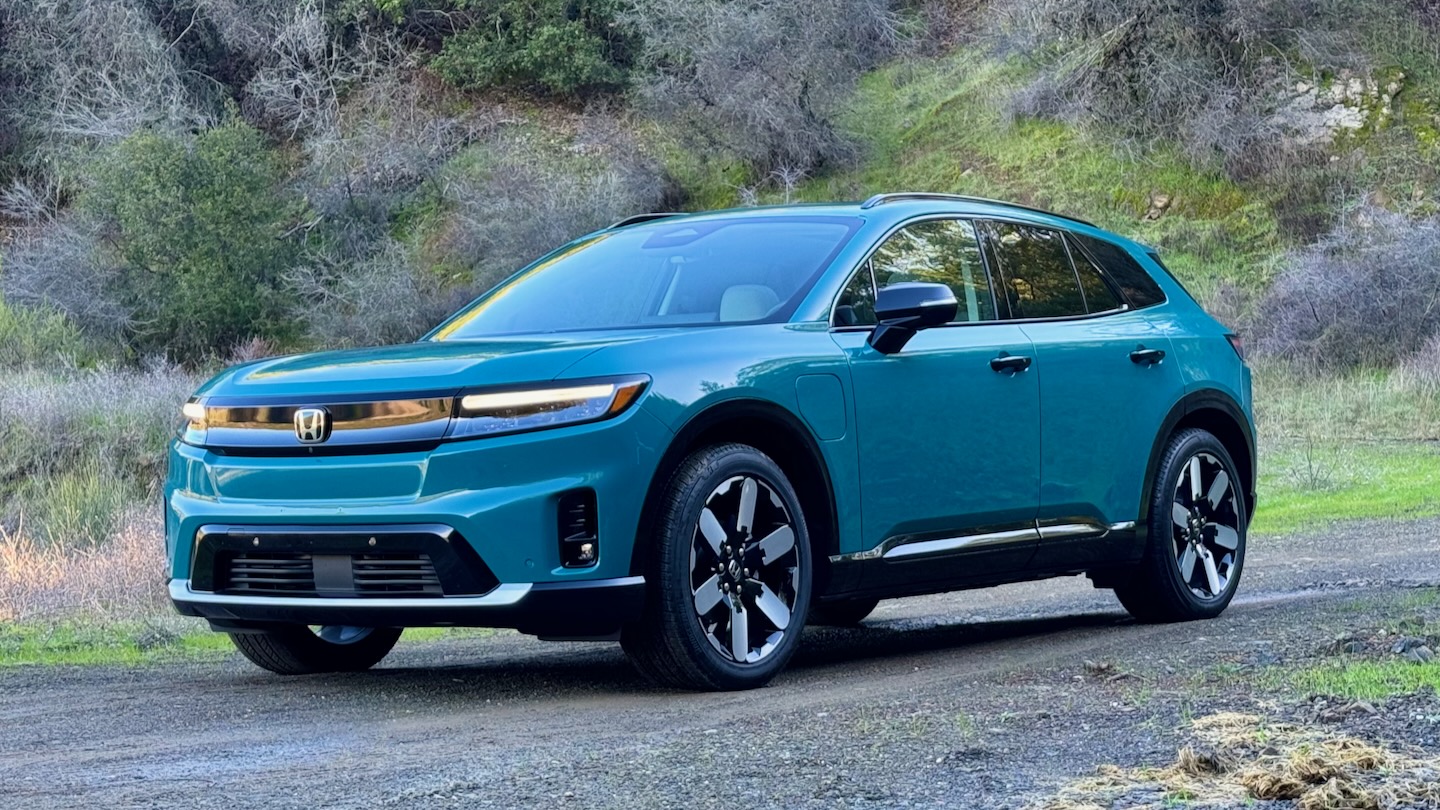Honda hasn’t been the fastest mover in electrification, but the 2024 Honda Prologue is a step in the right direction. When a car company starts planning a new model, the first step is designing the vehicle’s ideal hypothetical customer. When work began on the midsize Prologue electric crossover, they thought of someone a lot like me. Maybe even exactly me. I already drive an adequate crossover that I don’t particularly care about. My family activities require something larger than a sedan. I’d like an EV but don’t want something that advertises it. I’m fine with anything over 250 miles of range, and I’m not status-conscious. I also like specialty coffee and long bike rides if Honda wants to get real personal.
The Prologue checks all the boxes for most buyers. The EX front-wheel-drive single-motor base model has an EPA-rated range of 296 miles and that barely shrinks to 273 miles if you upgrade to the all-wheel-drive dual-motor fully-loaded Elite. It’s spacious inside, feels more premium than most competitors, looks decent enough without being flashy, and maybe most importantly, it doesn’t feel like a big switch from a current, conventional crossover.
| 2024 Honda Prologue Specs | FWD Single Motor | AWD Dual Motor |
|---|---|---|
| Base Price (Elite AWD as tested) | $48,795 | $51,795 ($59,295) |
| Powertrain | single motor front-wheel drive | 85-kWh battery | dual motor all-wheel drive | 85-kWh battery |
| Horsepower | 212 | 288 |
| Torque | 236 lb-ft | 333 lb-ft |
| Seating Capacity | 5 | 5 |
| Curb Weight | TBA | 5,200 pounds (est.) |
| Towing Capacity | 1,500 pounds | 1,500 pounds |
| Cargo Volume | 25.2 cubic feet behind second row | 54.5 cubic feet behind first row |
<< |
| Ground Clearance | 7.9 inches | 8.1 inches |
| 0-60 mph | TBA | 6.0 seconds (est.) |
| EPA Range | 296 miles | 281 miles (Elite trim: 273 miles) |
| Max DC Charging Speed | 155 kW | 155 kW |
| Quick Take | A solid offering from Honda that makes the switch to EVs easy for current owners of ICE crossovers, even if it might not be a “real” Honda. | << |
| Score | 7.5/10 | << |




The Basics
I suspect most of you know this already, but the Honda you’re staring at is actually a Chevy; more than one actually. It’s also a Cadillac. And it will be an Acura soon. So start working on your clever nicknames now for the Blazer, Equinox, Lyriq, ZDX, and Prologue. Having thought about it the entire flight home, I’m leaning towards Equilogue. The platform is GM’s Ultium, which also shares its battery technology and architecture with everything from Hummers to Escalade IQs; even Sierras and Silverados.
The Prologue wears a design language Honda refers to as neo-rugged; which to my mind is the person in full Patagonia whose idea of mountaineering is an occasional off-trail excursion at the disc golf course. It handsomely splits the difference between the somewhat bulbous and bland Equinox EV and the bro’ed-up Blazer EV. To put it in Honda context, the Prologue is roughly three inches longer than a Passport at 192 inches, a quarter of an inch narrower at 78.3 inches but 7.5 inches shorter in height at 64.7. In person, it looks sleeker than your average SUV. Aside from the solid black grille in front and the charging door in the front fender, most people wouldn’t suspect that it’s an EV. Those in the know will recognize the font used for the “HONDA” badge on the tailgate is reserved for the brand’s electric cars, but only salespeople, and now all of you, will realize that.





The Prologue’s low roofline necessitates a lower seating position from the typical crossover barstool. A low hip point and more stretched-out heel position remind me of the original Acura ZDX, still one of my favorite Honda products. The Prologue’s interior is spacious and full of storage. Honda claims four inches more legroom than competitors without naming them, but a quick look at the Tesla Model Y and Kia EV6, which are slightly smaller vehicles, says the Prologue’s 39.4 inches is about average. Either way, the materials are nice, and the two-tone leather looks and feels more premium than the class requires. The two front cupholders are designed to fit 32-ounce Hydroflasks—shots fired, Subaru! There are plenty of modern necessities: two USB-C ports in the front and two in the rear, a 12-volt socket up front, a 110-volt in back, and a somewhat poorly designed wireless charging pocket in the front console. A phone sits upright in the pocket and tips over when turning—a small nit to pick.
I do, however, joyously celebrate Honda’s use of physical buttons and knobs for HVAC and seat temperature. There’s even a volume knob standing proud beside the 11.3-inch infotainment screen. I know, commenter, you hate the unintegrated screen, but average car buyers reportedly love them. The gauges are supplemented by another 11-inch screen which looks fine. The Elite trim you see in the photos includes a head-up display, also fine. Standard on all trims is Google Built-In, along with wireless Apple CarPlay and Android Auto. Wireless CarPlay with my iPhone 15 Pro Max running iOS 17.3 worked flawlessly—YMMV with your particular phone and OS.
All trim levels of the Prologue (EX, Touring, and Elite) include keyless entry and push-button start, but the top Elite trim includes Smart Access. Instead of using the standard keyfob, you can carry what looks like a hotel room key card which you hold up to the door handle to lock/unlock the car. So, either carry a bigger keyfob that stays in your pocket/purse or have to take the credit card-sized key out of your pocket to use. The person who came up with this definitely wears their work badge on a lanyard at all times as per company policy.




Driving Experience
Honda hosted the Prologue drive event in Healdsburg, California. It’s the wine and Birkenstocks part of the state, not Disneyland and movie studios—home to amazing canyon roads, the type that crossovers full of families generally avoid. The Ultium platform has a lot going for it; the low seating position, multi-link suspension tuned by the same people that made the Civic Type R, a battery pack sitting at the lowest point, and 21-inch wheels. All these things should add up to a fun-to-drive experience. It isn’t fully realized.
First, the positives. Most crossovers are powered by two-ish liter, four-cylinder turbos connected to either CVTs or automatics with more gears than they know what to do with. They deliver binary throttle-response of either lazy or frantic acceleration, and most of them sound terrible. Electric powertrains, this one particularly, offer a high level of throttle modulation, instant response, and more than adequate power. I only drove the 288-hp all-wheel-drive Prologue, so I can’t speak to the front-drive 212-hp version. The powertrain also delivers a mechanical thrum that covers up just enough noise to make the interior feel pleasant at highway speeds. It may not have 9,000 lb-ft of torque, but this is the kind of EV that converts the masses.


Honda says the suspension tuning is completely its own, but the Prologue doesn’t feel like most Hondas. High-frequency hits, like cracks in the pavement and small potholes, are more jarring than expected. Low-frequency stuff like rises and falls at higher speeds are a little floaty. The 21-inch wheels could be partially to blame for the impacts, so the trim levels with 19-inch wheels may shake off impacts more gracefully. My own experience tells me the average buyer may not notice any of this or some will even consider it part of the SUV experience.
The twisty roads of the drive route also worked to highlight how lazily the Prologue’s steering reacts. Part of the slow steering is an 18.5:1 steering ratio, most crossovers in this class are right around 15:1 with quick steerers like a Subaru Outback using a rack with a 13.5:1 ratio. On top of that, there’s quite a bit of steering gain, which is how quickly inputs create increased turning motion. This is caused by bushings and flexible parts of suspension and steering gear having to “load up” before the car reacts. Add a lack of feel around the steering center and this isn’t anything like a Civic. I’m probably making too much of this, as again, only enthusiast buyers will care.
Honda Prologue Features, Options, and Competition
As I am sure you read in the spec box, the base single-motor front-wheel drive Prologue EX starts at $48,795 including $1,395 for destination. The FWD Touring model comes in at $53,095 with destination, and AWD is a $3,000 option on either of those trims. The $59,295 Elite trim is AWD-only. Buyers should remember the Prologue is eligible for a $7,500 federal tax credit.


Honda includes a choice of Prologue Charging Packages with all trims. For those relying on public charging, one option provides Prologue buyers with $750 in credits to use at EVgo charging stations. The second option provides $300 in EVgo credits, a portable charger, and $250 in credits for home wiring. A final home-centric option provides $100 in EVgo credits, a Level 2 home charger, and $500 in credits for installation. The Prologue is capable of 150-kW DC fast charging which delivers a claimed 65 miles of range in 10 minutes and 20% to 80% charge in about a half hour.
When it comes to competitors, the Model Y boasts similar interior space. The Tesla name carries some baggage but is still on the list. Likewise, Hyundai’s Ioniq 5 and Kia’s EV6 are both very similar in interior dimensions and performance specs, while delivering a comparable driving experience. If there’s any conclusion when looking at this crossover space, it’s that there isn’t a clear standout.

The Early Verdict
As I am typing this, the average price of a new car sold in the United States is $48,759 and half of the top 10 best-selling passenger vehicles for 2023 are CUV/SUVs, one of them is electric. The 2024 Honda Prologue slots right into the hotspot of the market and offers a compelling value proposition.
The Prologue name is a little on the nose. This is a teaser for Honda’s move to electrification and some will consider this nothing more than a badge-engineered placeholder before Honda’s actually-made-in-house 0 Series EVs come into play. But, if you ignore the fact that it’s on a shared platform, most buyers in the CUV market are going to be perfectly happy with it. Even those switching from gasoline.



Read More
Who Makes The Engines For NASCAR Truck Series?
Which Way, Modern Rider? / Zen And The Art Of Adventure From Any Angle
